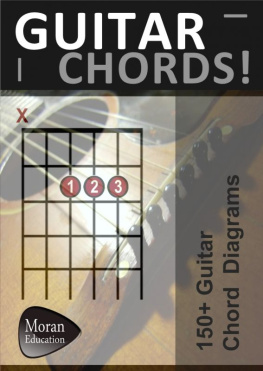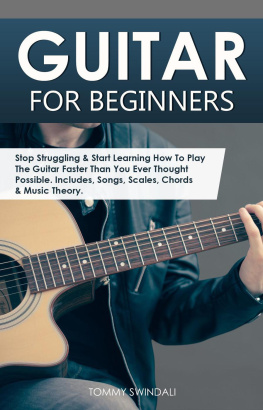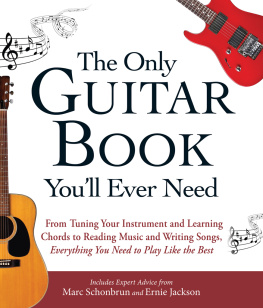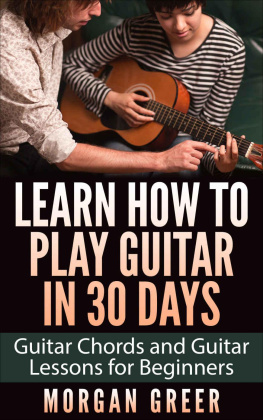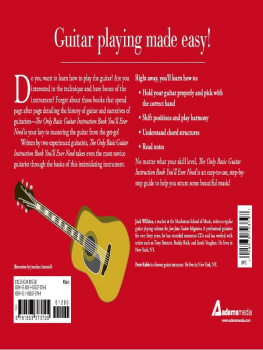Bob Fetherolf - Learning to Play Guitar: Exploring Scales and Chords
Here you can read online Bob Fetherolf - Learning to Play Guitar: Exploring Scales and Chords full text of the book (entire story) in english for free. Download pdf and epub, get meaning, cover and reviews about this ebook. year: 2012, publisher: BookBaby, genre: Children. Description of the work, (preface) as well as reviews are available. Best literature library LitArk.com created for fans of good reading and offers a wide selection of genres:
Romance novel
Science fiction
Adventure
Detective
Science
History
Home and family
Prose
Art
Politics
Computer
Non-fiction
Religion
Business
Children
Humor
Choose a favorite category and find really read worthwhile books. Enjoy immersion in the world of imagination, feel the emotions of the characters or learn something new for yourself, make an fascinating discovery.
- Book:Learning to Play Guitar: Exploring Scales and Chords
- Author:
- Publisher:BookBaby
- Genre:
- Year:2012
- Rating:5 / 5
- Favourites:Add to favourites
- Your mark:
- 100
- 1
- 2
- 3
- 4
- 5
Learning to Play Guitar: Exploring Scales and Chords: summary, description and annotation
We offer to read an annotation, description, summary or preface (depends on what the author of the book "Learning to Play Guitar: Exploring Scales and Chords" wrote himself). If you haven't found the necessary information about the book — write in the comments, we will try to find it.
Bob Fetherolf: author's other books
Who wrote Learning to Play Guitar: Exploring Scales and Chords? Find out the surname, the name of the author of the book and a list of all author's works by series.
Learning to Play Guitar: Exploring Scales and Chords — read online for free the complete book (whole text) full work
Below is the text of the book, divided by pages. System saving the place of the last page read, allows you to conveniently read the book "Learning to Play Guitar: Exploring Scales and Chords" online for free, without having to search again every time where you left off. Put a bookmark, and you can go to the page where you finished reading at any time.
Font size:
Interval:
Bookmark:
ISBN: 9781624880100
Welcome to Learning To Play Guitar: Exploring Chords and Scales, and congratulations! You are about to enter a very exciting phase of your adventures with your guitar and music. The joys of playing melodies and improvising solos, as well as rhythm guitar, chordal melodies, hot lead guitar licks and so much more are about to be explored, discovered and mastered by you! This book will introduce to you the tools you need to master the guitar and to broaden your understanding of the guitar and the music theory as it applies to the guitar, be it an acoustic or electric. This book contains over 130 pages of illustrations on intermediate and advanced learning concepts and techniques for guitar. It is literally two books in one! Of course there is always more to learn, but once you have understood and mastered these concepts, there will be nothing you cannot play on guitar. These accelerated learning concepts will give you a solid foundation that will last a lifetime! One primary goal for you to achieve here is the unification and understanding of the entire guitar fretboard. To achieve this we will include: Scales and Modes (modern and classical), Pentatonic and Blues Scales, Arpeggios and Exercises, as well as an excellent chord collection that will get you playing rhythm and lead guitar very quickly. One such method for achieving this vision is the study of the Ionian mode family or commonly known as the Modes. This subject will be covered in depth. The information to follow will also prepare the student of guitar for the most advanced studies in jazz theory if you choose to continue on into the next dimension or the final frontiers of guitar study!
The acronym CAGED stands for a guitar system for learning chords and their related scales (as was touched on in book one). This system will help solidify the concept of learning primary chords and shapes in the five primary guitar chord keys using the barre (pronounced bar). Once learned, the process of transposing them to the other seven keys will complete the students knowledge and mastery of these concepts. This is a much more efficient way of learning chords and scales for guitar than rote memorization. However, it is important to remember that the acronym; CAGED , while convenient and easy to remember, serves its purpose. But at some points in this study, the order of keys may appear in their natural order emphasizing the ever important cycle of fifths.
The 300 plus years of guitar history and pedagogical literature and technique is also a part of this solid foundation of guitar learning. Within these pages are included methods that are now proven to be more effective than older methods: the result of a few hundred years of existing study. What we have hear is Guitar Learning for the 21st Century and beyond. Therefore, both classical and modern scale pedagogues will be included and contrasted. As well, this book is intended to be a follow up and extension to Book #1. Some of the concepts introduced in book one will be explored in greater depth. Some concepts will be revisited as a refresher and new ones will be introduced.
Although this book is a complete and valuable work, it is also a companion work to book #1 (Learning To Play Guitar: Beginning and Intermediate Guitar Lessons). With well over three decades of teaching and studying music and three music degrees from CSULA, UCLA, MIT and more, I have done my best to present the best and most updated information available in an easy to understand and tried and true method for the 21st century and beyond! I humbly wish you much success in your study of guitar and thank you for your interest in this book. In closing I shall point out that much of the information is available on internet and other resources (library, music stores, bookstores, etc), but this book gives the student of guitar a-one stop- collection and resource to reference and study. Congratulations and good luck.
It goes without saying that once you learn the guitar fretboard, life as a guitarist will be easier in every way. When you can see (visualization) and understand the fretboard as one continuous pattern you are on your way to mastery of the guitar! Learning how to build chords and scales and solos across the neck is what this book is all about. In our study of the major scale, also called the Ionian mode, we will master what is arguably the most important scale of music. As mentioned previously, you will see the word VISUALIZATION a lot . This is because it is important that you are able to see the similarity of patterns and shapes of the chord and scales patterns that exist on guitar. And that is what we mean when we refer to visualization: recognizing and memorizing the similarities of these patterns and how they relate to each other and how they relate to music. The technique of visualization will assist and accelerate your learning of them! Now lets review some concepts that you probably already know, but practice makes perfect.
*Understand that when divided in half, a string produces the same note, but an octave higher.
*Understand that basically there are only 12 possible tones on a guitar (or a piano). They repeat in lower and higher registers, but a C is a C whether high or low. In other words, the octave is subdivided into 12 steps. Each is represented on the guitar neck by a fret. After the twelfth fret the notes repeat and octave higher. (Note: there are bent notes and semi tones in other forms of music around the world but that does not concern us now)
*Understand the distance between the strings (the fancy term is intervallic relationship). Each pair of adjacent strings is separated by a perfect fourth, except for the 3rd and 4th strings. If you have problems understanding intervals, go back to that, and come back then .
*Learn how a major scale is played on any single string. This will get you thinking of the entire fretboard as one continual entity. Focus on where the notes are. Single string scale diagrams are provided in the following pages.
*Say the names of the notes out loud as you play the major scales weve just discussed.
*Try to sing everything you play. This will engage your sense of hearing at a far deeper level. It will help you grasp the fretboard from an intuitive point of view. If you cannot, do not worry too much about it. Just work on it.
*Visualize all of what you have learned in your minds eye. Form a clear mental picture of it, and picture yourself going over all the steps. Practice as much as you can (at least 15 minutes a day) until the images are clear and sharp. I practiced at times for ten or twelve hours a day (or more) so the 15 minutes is minimum.
This book contains clear and easy to understand written instructions and excellent diagrams and other features to deliver a first rate educational experience. These include photographs, pictographs, chord diagrams , guitar tablature, chord chart progressions and of course standard music notation.

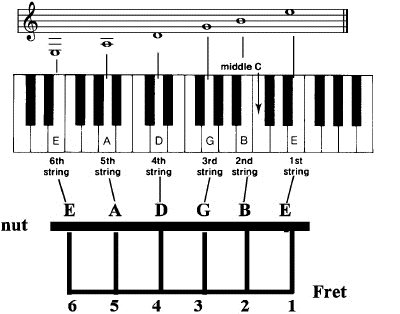
* The guitar may be tuned to the piano. The six strings are shown above as their pitch corresponds to the piano. The notes as they are written on the staff are give directly above the piano keys.
* Pitch pipes and sophisticated tuners are often used to tune the guitar as well.
Next pageFont size:
Interval:
Bookmark:
Similar books «Learning to Play Guitar: Exploring Scales and Chords»
Look at similar books to Learning to Play Guitar: Exploring Scales and Chords. We have selected literature similar in name and meaning in the hope of providing readers with more options to find new, interesting, not yet read works.
Discussion, reviews of the book Learning to Play Guitar: Exploring Scales and Chords and just readers' own opinions. Leave your comments, write what you think about the work, its meaning or the main characters. Specify what exactly you liked and what you didn't like, and why you think so.




